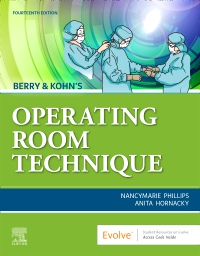
Berry & Kohn's Operating Room Technique, 14th Edition
Paperback

Now $125.83
**Selected for Doody’s Core Titles® 2024 with "Essential Purchase" designation in Perioperative** Easily learn how to apply basic surgical principles and techniques with Berry & Kohn’s Operating Room Technique, 14th Edition. For over 50 years, this highly readable text has been trusted to clearly cover the "nuts and bolts" of surgical techniques in a step-by-step format. Expert authors Nancymarie Phillips and Anita Hornacky emphasize the importance of teamwork throughout, with practical strategies and examples of how cooperation among perioperative caregivers contributes to positive patient care outcomes. With a strong focus on the physiologic, psychologic, and spiritual considerations of perioperative patients, this extensively updated new edition gives you the knowledge you need to plan and implement comprehensive, individualized care.
-
- Detailed information on the fundamentals of perioperative nursing and surgical technology roles enhance students’ understanding of basic surgical principles and techniques.
- Emphasis on teamwork among perioperative caregivers encourages cooperation in attaining positive patient care outcomes.
- In-depth discussions of patients with special needs related to age or health status help students learn how to develop a plan of care tailored to the unique care needs of all patients.
- Focus on the physiologic, psychologic and spiritual considerations of patients gives students the knowledge they need to plan and implement comprehensive, individualized care.
- Vivid high-quality illustrations reflect the latest in perioperative procedures and provide key safety information.
- Coverage of both inpatient and ambulatory procedures highlights key considerations for each settings as well as for individual surgical procedures.
- Chapter outlines with page numbers, chapter objectives, and key terms and definitions help students quickly find important information and focus study time.
- Enhanced TEACH manual and extensive Evolve resources maximize classroom learning.
- Step-by-step coverage of the foundations of surgical techniques enables students to effectively apply basic principles to practice.
- Updated tables and boxes call attention to the most important concepts from the text.
- References highlight the evidence-based practice approach used throughout the text.
-
- NEW! Updated evidence-based content reflects the 2019 AORN Guidelines for Perioperative Practice and covers: recommendations for attire; revisions in sterilization and instrument processing; FDA standards, recalls, and approvals; CDC updated screening data; current technology and instrumentation; prevention and treatment of surgical infection; recommendations for perioperative patient care, documentation, and hand-over; updated surgical facility requirements; and more.
- NEW! Current recommendations for the comprehensive surgical checklist have also been incorporated in the text.
- NEW! Updated practice examination has been added to the perioperative education and learning activities.
- NEW! Explanation of PNDS provides students with a solid understanding of the Perioperative Nursing Data Set.
- NEW! Legal and ethical implications for practice ground students in the importance of proper skill performance and thoughtful decision-making.
-
Section 1: Fundamentals of Theory and Practice 1. Perioperative Education 2. Foundations of Perioperative Patient Care Standards 3. Legal, Regulatory, and Ethical Issues
Section 2: The Perioperative Patient Care Team 4. The Perioperative Patient Care Team and Professional Credentialing 5. The Surgical First Assistant 6. Administration of Perioperative Patient Care Services
Section 3: The Patient as a Unique Individual 7. The Patient: The Reason for Your Existence 8. Perioperative Pediatrics 9. Perioperative Geriatrics
Section 4: The Perioperative Environment 10. Physical Facilities 11. Ambulatory Surgery Centers and Alternative Surgical Locations 12. Care of the Perioperative Environment 13. Potential Sources of Injury to the Caregiver and the Patient
Section 5: Surgical Asepsis and Sterile Technique 14. Surgical Microbiology and Antimicrobial Therapy 15. Principles of Aseptic and Sterile Technique 16. Appropriate Attire, Surgical Hand Hygiene, Gowning and Gloving 17. Decontamination and Disinfection 18. Sterilization
Section 6: Surgical Instrumentation and Equipment 19. Surgical Instrumentation 20. Specialized Surgical Equipment
Section 7: Preoperative Patient Care 21. Preoperative Preparation of the Patient 22. Diagnostics, Specimens, and Oncologic Considerations
Section 8: Pharmacology and Anesthesia 23. Surgical Pharmacology 24. Anesthesia: Techniques and Agents
Section 9: Intraoperative Patient Care 25. Coordinated Roles of the Scrub Person and the Circulating Nurse 26. Positioning, Prepping, and Draping the Patient 27. Physiologic Maintenance and Monitoring of the Perioperative Patient
Section 10: Surgical Site Management 28. Surgical Incisions, Implants, and Wound Closure 29. Wound Healing and Hemostasis
Section 11: Perianesthesia and Postprocedural Patient Care 30. Postoperative Patient Care 31. Potential Perioperative Complications
Section 12: Surgical Specialties 32. Endoscopy and Robotic-Assisted Surgery 33. General Surgery 34. Gynecologic and Obstetric Surgery 35. Urologic Surgery 36. Orthopedic Surgery 37. Neurosurgery of the Brain and Peripheral Nerves 38. Spinal Surgery 39. Ophthalmic Surgery 40. Plastic and Reconstructive Surgery 41. Otorhinolaryngologic and Head and Neck Surgery 42. Thoracic Surgery 43. Cardiac Surgery 44. Vascular Surgery 45. Organ Procurement and Transplantation

